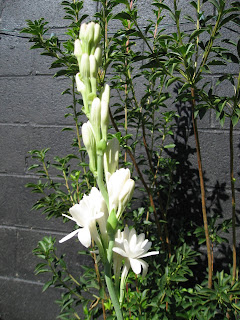.jpg)

The rampant chartreuse vine spilling from planters all over New York is Ipomoea ‘Marguerite,’ aka the Sweet Potato Vine.
A lot of people started planting Marguerite about 10 years ago, but I can’t quite get used to her as a rank and file member of our flora. She’s a dominatrix, and her vigor has a supernatural, mutant-Kudzu quality. Still I use her in new plantings all the time because she makes a fast start and gives everyone the impression that they know what they are doing. Marguerite is a tender tropical, and fortunately she’s laid flat by the first frost.
There are a few other Ipomoeas, including black leaved ones that can be used to macabre effect. “Blackie” has a divided leaf and nice violet flowers that resemble morning glory, which is in the same genus. I’ve never noticed flowers on other Ipomoeas.
‘Carolina Bronze’ has an interesting bronze brown leaf that mixes poorly with most other plants. I’ve liked seeing it grown with Coleus ‘Trailing Red’ and the scarlet dahlia with dark leaves called ‘Bishop of Llandaff.’ It also looks good at the base of big blue-leafed agaves. Generally Carolina lends herself to sophisticated, highly edited planting schemes of foliage in muted pastels.
‘Tricolor’ is just awful. Its leaf is green mottled with white, lavender and pink.
A lot of people started planting Marguerite about 10 years ago, but I can’t quite get used to her as a rank and file member of our flora. She’s a dominatrix, and her vigor has a supernatural, mutant-Kudzu quality. Still I use her in new plantings all the time because she makes a fast start and gives everyone the impression that they know what they are doing. Marguerite is a tender tropical, and fortunately she’s laid flat by the first frost.
There are a few other Ipomoeas, including black leaved ones that can be used to macabre effect. “Blackie” has a divided leaf and nice violet flowers that resemble morning glory, which is in the same genus. I’ve never noticed flowers on other Ipomoeas.
‘Carolina Bronze’ has an interesting bronze brown leaf that mixes poorly with most other plants. I’ve liked seeing it grown with Coleus ‘Trailing Red’ and the scarlet dahlia with dark leaves called ‘Bishop of Llandaff.’ It also looks good at the base of big blue-leafed agaves. Generally Carolina lends herself to sophisticated, highly edited planting schemes of foliage in muted pastels.
‘Tricolor’ is just awful. Its leaf is green mottled with white, lavender and pink.
I think we are just getting started with Ipomoea. New varieties are introduced every year, including one marketed as a more “restrained” version of Marguerite.





